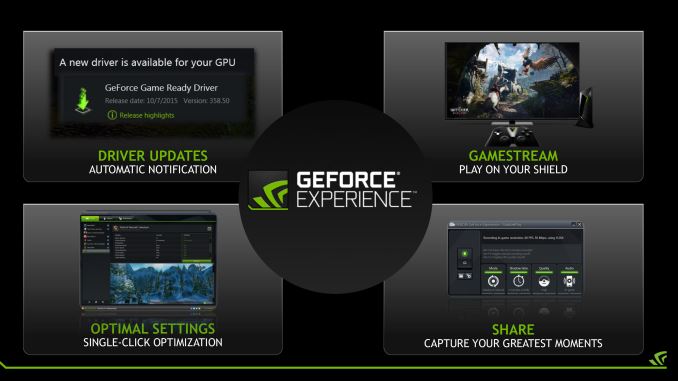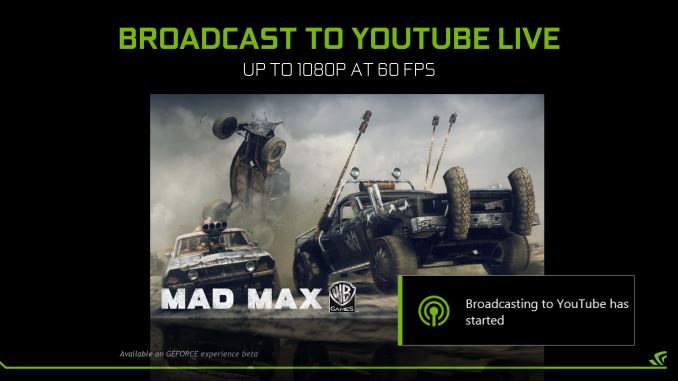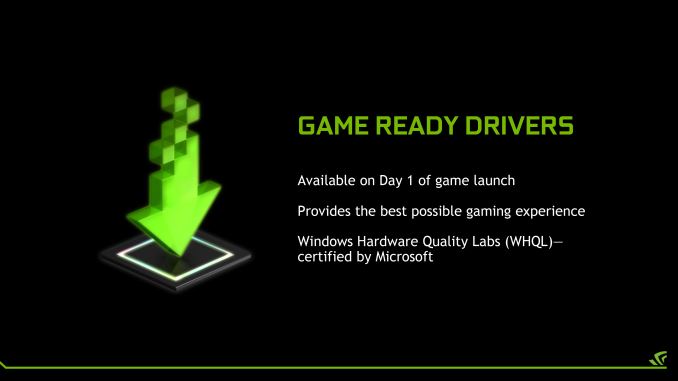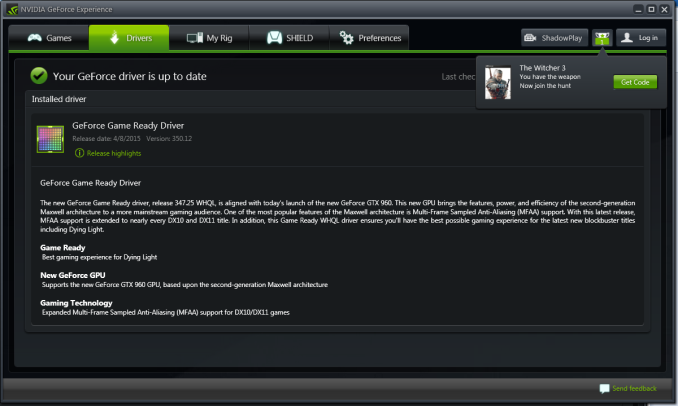NVIDIA GeForce Experience Update: 4K GameStream & 1080p Twitch; Driver Update Changes To Come
by Ryan Smith on October 15, 2015 9:00 AM EST- Posted in
- GPUs
- GeForce
- NVIDIA
- GeForce Experience

Since launching their GeForce Experience software utility over two years ago, NVIDIA has continued to iterate on it in a fairly regular fashion. Along with its software update and game settings optimization features, NVIDIA has added a number of features over the past couple of years tied to their NVENC hardware encoder, including GameStream, ShadowPlay, and most recently the beta for Share and GameStream Co-Op. As one might expect, NVIDIA is not stopping there, and in a briefing to the press this week, NVIDIA is announcing some of their feature development plans for GeForce Experience over the next couple of months.
To kick things off, in a new beta release hitting NVIDIA’s servers today, NVIDIA will be updating several of GeForce Experience’s various NVENC-powered features to enable new features. On the GameStream front NVIDIA will be offering new functionality specifically targeted at the recently launched SHIELD Android TV set top box. With the SHIELD Android TV capable of decoding 4K video content, NVIDA is now giving GameStream the ability to encode video at that resolution, allowing for GameStream remote gaming at full native resolution for 4K TVs. Furthermore NVIDIA is also giving GameStream the ability to serve up 5.1 audio.
Until this latest release GeForce Experience had been limited to serving up GameStream with 1080p video and stereo audio, so this marks a significant increase in GameStream’s video and audio quality. At the same time because of the step up in quality the system requirements to use the new 4K mode are significantly higher as well. On the encode side only the newest Maxwell 2 generation GPUs have an NVENC unit capable of encoding at 4Kp60, so high-end Kepler users won’t see this functionality. Meanwhile on the reception side, a SHIELD Android TV is needed to receive 4K video, and NVIDIA is recommending a hardwired 100Mbps (or better) Ethernet connection for best performance. And on a technical side note, though not specified in NVIDIA’s presentation, as 4K support is limited to SHIELD Android TV I’m curious whether NVIDIA is still using H.264 or if they’re switched to HEVC, as Maxwell 2 and SHIELD Android TV support hardware HEVC encoding and decoding respectively.
Moving on, similar to GameStream, GeForce Experience’s video broadcasting module is also getting new functionality and an image quality boost. First launched with Twitch support back in late 2013, the broadcast module is now gaining support for Google’s rival YouTube Live service as well, allowing GeForce users to broadcast to the service of their choice. Furthermore the broadcast module can now upload video streams at 1080p60 with a maximum bitrate of 9Mbps, supplanting the module’s previous 720p60 limit. As even older versions of NVENC have long been able to record at 1080p, this change primarily appears to be NVIDIA increasing their limits now that these services are better able to handle the high bitrates that go with 1080p streaming.
The Next Few Months: Driver Updates Shift to GeForce Experience
Finally, in their last announcement for the day, NVIDIA is sharing a bit of information on their plans for GeForce experience for the rest of the year, and this is a big one.
Starting with a December update to GeForce Experience, NVIDIA will be overhauling how they distribute their driver updates. The company currently posts new drivers on a regular basis to their website while also simultaneously pushing them out via GeForce Experience. Come December, that will be changing and GeForce Experience will be the preferred “first access” distribution mechanism for NVIDIA’s frequent driver updates.
This change comes on the heels of NVIDIA’s latest research, which finds that 90% of all driver updates are now distributed through GeForce Experience. At this point NVIDIA is not discussing the change in great detail – and most likely they’re still sorting out the finer details of what they want to do – but the basic idea is to fully exploit the push update mechanism of GeForce Experience while drawing users into what will in time become a larger NVIDIA ecosystem. GeForce Experience will be used to distribute the company’s regular “point release” driver updates that the company frequently releases and typically contain bug fixes and performance improvements for gamers – in other words the drivers most gamers will want to be on. Meanwhile NVIDIA will still post drivers to their website (and by extension Windows Update), but on a reduced quarterly cadence.
One thing NVIDIA has made clear is that they’re sticking with their overall Game Ready driver release system – targeting frequent driver updates to line up with major game launches – and this includes WHQL certification, so this won’t be NVIDIA cutting back on WHQL releases despite the fewer updates to their website. However even with WHQL certification, NVIDIA’s frequent driver releases (20 in just over the last year, not counting hotfixes) have been both a curse and a blessing for their wider user base, as non-gamers use the same drivers. I get the impression that this change is in part driven by a desire to establish separate “gamer” and “long term” driver release cadences where non-gamers aren’t constantly being bombarded by Game Ready point updates that primarily affect software they aren’t using.
At the same time however NVIDIA is also being straightforward about this driver change being part of a broader effort to promote GeForce Experience from a utility to a critical part of the GeForce ecosystem and to make it a software backend of sorts to their GPUs. The change in driver distribution will be accompanied by a yet to be fully detailed registration system where NVIDIA will be asking users to register their email addresses with GeForce Experience. NVIDIA has already been toying with this concept this year by using GeForce Experience to distribute game codes, so while it’s not fully clear what NVIDIA intends to do with a registered user base this is clearly the latest step as part of building their ecosystem.
More broadly speaking, NVIDIA has been pushing the larger GeForce ecosystem concept for even longer than GeForce Experience has been around – through G-Sync, PhysX, 3D Vision, and other technologies – and the company has made it clear for years that they see their continued success as coming from not just offering gamers solid hardware, but offering a wholly integrated experience. Given that PC gaming is otherwise one of the few bright spots in a tough market for PCs – year-over-year worldwide sales were down 7.7% for Q3 – it makes a great deal of sense for NVIDIA to want to further bolster their hand in the PC gaming market.
I am however curious to hear more details in the coming months about how the registration mechanism and revised driver distribution system works in GeForce Experience, what else NVIDIA will be doing with their growing ecosystem, and what GeForce owners think of this. Web based driver updates are older than the formal concept of the GPU, so NVIDIA’s plans mark a significant change in how drivers are at least preferably distributed. Though to NVIDIA’s credit they have clearly thought this through – even downgrading has been considered and NVIDIA will be building in a downgrade mechanism into the GeForce Experience driver update module. And ultimately with NVIDIA’s 90% distribution figure, it would appear that web downloads were already a quickly dying trend anyhow.
Wrapping things up, NVIDIA tells us these latest and upcoming improvements to GeForce Experience will be followed by further improvements for GeForce Experience in 2016. NVIDIA has stated that they have an “interesting roadmap” for the utility for the next year, one that will no doubt further flesh out this software ecosystem that the company is quickly assembling.














54 Comments
View All Comments
limitedaccess - Thursday, October 15, 2015 - link
I don't really understand why they would want to be doing this though for the drivers.This just seems like it is going to draw fire from at least a vocal minority crowd and cause massive controversy. While I don't see how have simultaneous website driver releases really is any significant added cost?
nathanddrews - Thursday, October 15, 2015 - link
To their credit, NVIDIA has been on a path to make PC gaming as simple as possible for the masses - the 90% that use GFE simply because it installs by default. The downside, IMO, is that simplicity comes with a price. To build a console ecosystem on the PC, you need to utilizes proprietary software, services, and devices (GFE, G-Sync, SHIELD, GameWorks, GRID, etc.) to establish a common experience. What's clear is that NVIDIA is striving to compete with Sony and Microsoft, not AMD.Valve has been trying to do this all through software, but is quickly learning that getting hardware out in the world is just as important. Microsoft tried (and failed) with GFWL and is trying again with Xbox Live for Windows 10 and more integration with Xbone, but neither company seems to be offering anywhere near the features of the NVIDIA ecosystem for the PC.
ddriver - Thursday, October 15, 2015 - link
God forbid the masses need to make a mental effort in order to do something. Next thing you know, people begin using their heads for something other than a balancing weight and a place to put fancy hats.nathanddrews - Thursday, October 15, 2015 - link
It's not really about intelligence. I would argue that time savings drives more of this than anything else. Most people that I know that choose consoles over PC gaming don't do so due to a lack of intelligence or ambition, but do so because they "just want to play a game without the hassle" between mowing the lawn and putting the kids to bed.While it's fun to spend 5 hours or 5 days running benchmarks and tweaking clockspeeds and cooling systems to achieve the best performance, some people would rather being playing games all that time even if the textures are bad and the frame rate gets choppy. "It just works" is more than just a marketing phrase.
As long as NVIDIA doesn't remove the option for the 10% that want full control over everything, what is there to complain about?
ddriver - Thursday, October 15, 2015 - link
It's not really about what it is the product of, but what is its product. The first guy to order food delivered to his home probably didn't do it because he couldn't cook, but a few generations into it, and then you have it - people who couldn't cook a meal if their life depended on it.Nvidia is pushing things like game streaming, which involves significant latency that only a slob will be ok with, this could not possibly compare to running a game on your own machine.
The nonsense about wasting 5 days into optimizing your system is just that - nonsense, you could not possibly squeeze enough performance out of that to make it a game changer. It is just what the industry wants people to believe is being spared.
Leaving others to do your thinking is intrinsically bad, this is why today we eat garbage, drink garbage and breathe garbage. Because we listened to some "good person" who offered to do it for us, even though he didn't gave a broken dime about us.
When you use progress, your life gets better, when the industry uses progress to package YOU as the product in order to milk you better, the end result is degradation.
ddriver - Thursday, October 15, 2015 - link
In short, the "geforece experience" - it sucks, but it is easy. So better lower your standards and just be a happy camper, after all, the whole purpose is making money on you. Be a good piece of cattle and make your milking easier.nathanddrews - Thursday, October 15, 2015 - link
That's a strange argument. I don't know about you, but I don't know everything, and I don't excel at every single thing. No one person could ever. I'm great with computing, but not very good at gardening. I'm great at cooking, but not very good at baking. I feel no shame relying on others to grow vegetables and make bread that I can easily buy in the store. Yes, I know that those breads and produce I buy cost way more in the store than it would be to do it myself... but does that make a person lazy or a slob?Likewise, I enjoy building my own desktop computers and my own desks to place them on, but I won't hesitate to buy a router or network cables if I can avoid building my own. Why? Because I got sh*t to do! LOL
We should be so lucky that PC gaming has come far enough that there are options like this for people that would otherwise never consider getting into PC gaming.
ddriver - Thursday, October 15, 2015 - link
Granted, no one person is capable of knowing and being able to do everything, but hey, baking is not rocket science. It probably won't take for you a long time to learn it.Then again, there is the prospect of saving yourself the time. You could have a friend bake for you, and in exchange you cook for him. That's all good, because it will still be about baking. bread.
But in the industry it is not about baking bread. It is about profit. I have found mercury in bread, and guess what, that factory which produced it is still working.
They market is as if it is done for the sake of your comfort, but in reality it is for the sake of their comfort. The industry will NEVER EVER make a concession for the sake of the consumer. They will evaluate what is better for them, and they will market it as if it is better for you. They will wrap it up in some meaningless fad and try convincing people it is the best thing since sliced bread. And the sellout media will pick that up. Stream 4k content for gaming, which involves user reaction, and marketing that as a good thing - that's ridiculous. They don't do it because they care about your comfort or experience, they do it because they have estimated it will be more profitable for them, and your poor gaming experience is a small price to pay for their comfort.
You don't buy a router because it is too much of a hassle to "build" one, but because there is no option to do it. You can buy PC components and assemble a system, but you can't do that for a router. You have NO CHOICE but to purchase one, most likely plagued by security flaws and backdoors installed by either the manufacturer, or when the NSA intercepted the hardware shipment.
I mean, if there was the option to build your own router, and it have you the degree of flexibility you get from building your own system, I have zero doubts you will invest the ... like 10 minutes it would take to assemble those components into a working router unit. But you can't, you don't even have that option. You could pick up a microcontroller, design your own circuit, write your own software and build a router this way, but it will take a lot of time and effort, it will be proportional to "building a PC" by means of designing your own CPU and GPU, go through the manufacturing and so forth - practically impossible to do as an individual.
Morawka - Thursday, October 15, 2015 - link
ddriver, welcome to life budin order for any company/person to make a profit (or money for that matter), they need to have something someone else wants.
That's life man.
Morawka - Thursday, October 15, 2015 - link
yes i'm gonna be vauge and not mention examples for you to string out and try and make a philosophical debate on it's merits. But just think about it, they couldn't make a profit on those things if people did not want them.